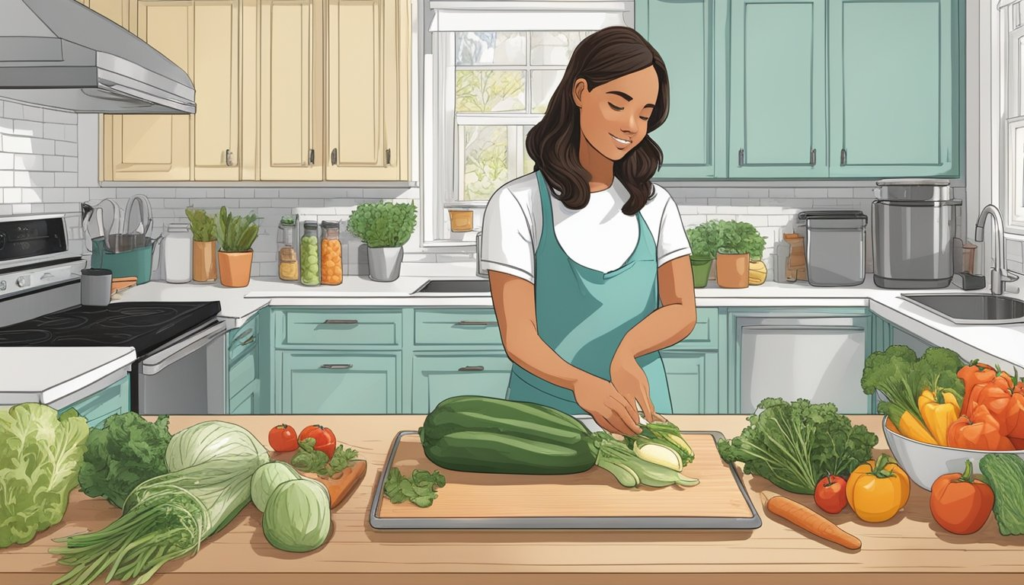Meal prepping is a practical approach to cooking that involves preparing ingredients or complete meals in advance to save time, reduce stress, and ensure you eat healthy, balanced meals throughout the week. Whether you have a busy schedule or are looking to improve your eating habits, meal prepping can simplify your routine while helping you stay on track with your nutrition goals.
This guide introduces the basics of meal prepping, including essential techniques, tools, and tips for getting started.
What is Meal Prepping?
Meal prepping involves planning, preparing, and cooking ingredients or full meals in advance, typically for the upcoming week. The goal is to make mealtime faster and easier while still enjoying nutritious, homemade food. Meal prepping can be as simple as chopping vegetables for the week or as comprehensive as cooking and portioning out all your meals ahead of time.
Types of Meal Prepping:
- Batch Cooking: Making large quantities of food (such as soups, stews, or casseroles) that can be divided into portions and stored for later use.
- Ingredient Prep: Preparing individual ingredients (like chopping vegetables or cooking grains) so they can be quickly assembled into meals.
- Full Meal Prep: Cooking entire meals in advance and storing them in portions for the week.
- Pre-Portioned Snacks: Preparing healthy snacks (such as yogurt, fruit, or nuts) that are ready to grab and go.
By using these techniques, meal prepping can fit any lifestyle, whether you prefer to prepare everything in advance or just certain components.
Benefits of Meal Prepping
Meal prepping offers several advantages beyond saving time. It encourages healthier eating, reduces food waste, and can save you money by preventing last-minute takeout or grocery runs.
Key Benefits:
- Saves Time: Meal prepping reduces the need to cook daily, freeing up time during busy weekdays.
- Encourages Healthy Eating: Prepping meals in advance makes it easier to stick to a healthy diet, avoiding impulsive food choices.
- Reduces Food Waste: By planning and portioning meals, you’re less likely to throw away unused ingredients.
- Supports Portion Control: Pre-portioned meals help manage serving sizes, which is particularly helpful for those with specific health or fitness goals.
- Saves Money: Prepping meals at home is more cost-effective than ordering takeout or eating out regularly.
With proper planning, meal prepping makes it easy to maintain a balanced diet while simplifying your daily routine.
Getting Started with Meal Prepping
Starting meal prep can feel overwhelming, but with a few basic steps, you’ll be able to build a system that works for you. Here’s how to get started.
Step 1: Plan Your Meals
The first step in meal prepping is deciding what you’ll eat for the week. Planning your meals helps you create a focused grocery list, making shopping easier and more efficient.
Tips for Planning:
- Choose Simple Recipes: Start with easy-to-make recipes that you can prepare in bulk. Meals like stir-fries, salads, soups, and grain bowls are great for meal prep.
- Incorporate Variety: While batch cooking is helpful, vary your ingredients to avoid boredom. Rotate different proteins, grains, and vegetables throughout the week.
- Use Ingredients for Multiple Meals: Choose ingredients that can be used in multiple dishes. For example, roasted vegetables can be added to salads, grain bowls, or wraps.
By creating a weekly meal plan, you’ll know exactly what to buy and prepare for the week.
Step 2: Grocery Shopping
Once you’ve planned your meals, it’s time to create a grocery list. Stick to your list to ensure you’re buying only what you need, which helps reduce food waste and keeps costs down.
Grocery Shopping Tips:
- Organize by Category: Divide your list into categories like vegetables, proteins, grains, and pantry items. This helps make shopping faster and more organized.
- Shop for Fresh and Frozen: While fresh produce is ideal for certain meals, frozen vegetables are convenient for quick additions to meals, especially if you’re prepping for the long term.
- Stock Up on Pantry Staples: Grains, beans, lentils, canned goods, and spices are versatile ingredients that can enhance your meals and last a long time.
Shopping efficiently sets the stage for a successful meal prep session.
Step 3: Meal Prep Essentials and Tools
Having the right tools and containers is crucial for efficient meal prepping. Invest in quality meal prep containers that are microwave-safe, freezer-safe, and airtight.
Essential Meal Prep Tools:
- Meal Prep Containers: Use durable, stackable containers that can store individual portions. Glass or BPA-free plastic containers work well.
- Mason Jars: Perfect for storing salads, overnight oats, or smoothies.
- Cutting Board and Knives: A sharp knife and large cutting board will make chopping ingredients easier and faster.
- Sheet Pans: For roasting vegetables, proteins, and even batch-cooking meals like sheet pan dinners.
- Slow Cooker or Instant Pot: These can be lifesavers for batch cooking stews, soups, and large portions of grains or proteins with minimal effort.
Having these tools on hand will make the meal prep process smoother and more efficient.
Step 4: Prepping and Cooking
Now that you have a plan and your groceries, it’s time to start prepping. Choose a day when you have time to dedicate a few hours to cooking and assembling your meals.
Meal Prepping Tips:
- Start with Ingredients: Begin by cooking the items that take the longest, such as grains (rice, quinoa) and proteins (chicken, beans). While they cook, chop vegetables and prepare other ingredients.
- Roast Vegetables in Bulk: Spread out vegetables on sheet pans with olive oil and seasonings, then roast them at once. Roasted veggies can be used in a variety of meals.
- Multi-task: While waiting for certain ingredients to cook, prepare salads, snacks, or sauces. This maximizes your time and keeps the process efficient.
- Portion Out Meals: Once everything is cooked, portion meals into containers. Label the containers with the meal and date to keep track of freshness.
Once your meals are portioned, store them in the fridge for quick access throughout the week.
Step 5: Storing and Reheating
Proper storage ensures your meals stay fresh and safe to eat. Depending on the meal, you may want to store some dishes in the fridge for immediate use and others in the freezer for later in the week.
Storage Tips:
- Fridge: Most prepped meals will stay fresh in the fridge for 3–5 days. Be sure to store cooked meals in airtight containers to maintain freshness.
- Freezer: Meals like soups, stews, and casseroles can be frozen for up to three months. Use freezer-safe containers, and thaw meals overnight in the fridge before reheating.
When you’re ready to eat, reheat meals in the microwave or on the stovetop, and enjoy a healthy, home-cooked dish with minimal effort.
Meal Prepping Tips for Success
Here are some additional tips to ensure your meal prepping experience is efficient and enjoyable:
1. Start Small
If you’re new to meal prepping, start with one or two meals a week rather than trying to prepare every meal. This helps ease you into the routine without feeling overwhelmed.
2. Keep it Simple
Focus on simple, versatile recipes that are easy to prepare in large batches. Once you get the hang of it, you can experiment with more complex dishes.
3. Use Leftovers Wisely
Leftovers from dinner can make excellent lunches the next day. Incorporate leftovers into your meal plan to reduce food waste and save time.
4. Adjust for Your Needs
Your meal prep plan should be flexible and work with your schedule. If you prefer fresh meals every day, you can prep ingredients rather than full meals to assemble quickly during the week.
5. Stay Organized
Keep your meal prep area clean and organized to streamline the process. Label containers with the date they were made to ensure you’re eating meals while they’re fresh.
Conclusion
Meal prepping is a powerful tool for maintaining a healthy diet, saving time, and reducing stress during the week. By planning meals in advance, organizing your groceries, and prepping ingredients or full meals, you can enjoy nutritious food with minimal daily effort. Whether you’re preparing for a busy week or just looking to simplify your routine, meal prepping sets you up for success.
Frequently Asked Questions (FAQ)
How long can meal-prepped food stay fresh in the fridge?
Meal-prepped food can typically stay fresh in the fridge for 3–5 days, depending on the ingredients. Make sure to store meals in airtight containers to maintain freshness.
Can I freeze meal-prepped meals?
Yes, many meal-prepped dishes, such as soups, stews, and casseroles, can be frozen for up to three months. Use freezer-safe containers, and thaw meals overnight in the fridge before reheating.
What are some easy meal prep ideas for beginners?
Some easy meal prep ideas include grilled chicken with roasted vegetables, quinoa bowls with mixed veggies and beans, overnight oats, and salads in mason jars.
Do I have to meal prep all my meals for the week?
No, you can meal prep as much or as little as you want. Some people prefer to prep breakfast and lunch only, while others prepare all three meals and snacks for the week.
How can I avoid getting bored with my meals?
To avoid boredom, vary your ingredients and seasonings. Rotate proteins, grains, and vegetables, and experiment with different spices and sauces to keep your meals exciting.



